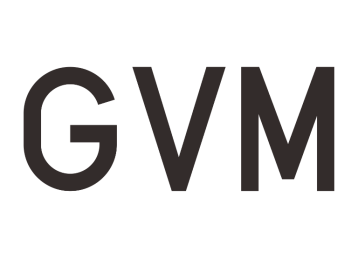Since the automobile is about as old as cinema itself, from the very beginning of motion pictures scenes have been staged in and around moving cars.
In the cinema’s infancy this was invariably done live and aided by the fact that many cars were convertibles anyway. By the time sound came in and unwieldy blimped cameras became the norm clearly something had to be done and various studio based rear projection techniques were invented. Rear process shots from this era rarely seem convincing to a modern audience today, but by the late 1950s rear projection in Hollywood features had reached a very high standard of excellence, and Hitchcock’s ”Vertigo” from 1958 is a good example of this.
But, in spite of this filmmakers began again in the late 1940s to experiment with shooting car scenes in actual cars on location. A great example of this is the very influential B-movie ”Gun Crazy” from 1950 which features very creative car interior shots, and by the 1970s shooting car scenes for real pretty much became the norm for discerning filmmakers.
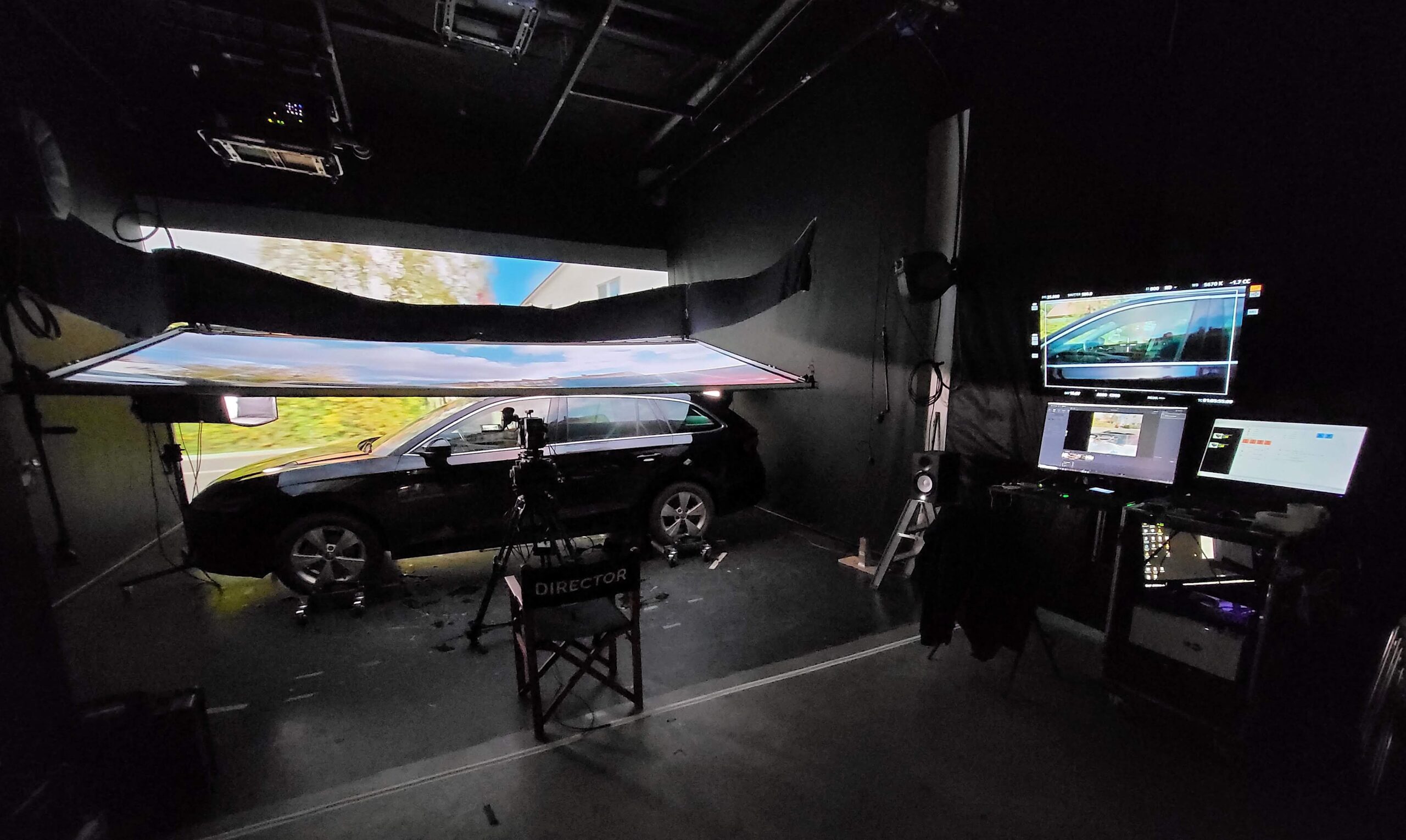
So, throughout the history of cinema we have gone from shooting car scenes for real, to rear projection techniques in the studio, and back to shooting in actual vehicles on location… and now we have arrived at what appears to be the best of both worlds! Using a set up such as the one at Igelkott Studios, a few miles north of Stockholm Sweden, car scenes can be staged with such realism that, looking at the finished results, it’s almost impossible to tell that this was shot in a studio.
A video shot at Igelkott Studios can be seen by clicking here.
Projection effects producer Eric Hasso is the proud co-founder of Igelkott Studios AB, and when we meet him he is standing in front of a car projection set up which, when you look at the various screens that surround us, could easily be mistaken for the real thing. The projectors are from Barco and they are part of a collaboration between projection specialist Vello Herman, Barco Sweden and Igelkott Studios AB.
”I started Igelkott Studios four years ago”, Eric explains, ”to take on the challenge of perfecting car scenes. The first TV show I worked on in that capacity was ”Älska Mig”, starring Josephine Bornebusch, and I’ve provided car scenes for a lot of productions since then. They’ve all used 4K 360°cameras, and that made me realize what would be expected in terms of resolution in the near future, and therefore back in 2020 I started developing a new 8K 360° camera for shooting background plates.
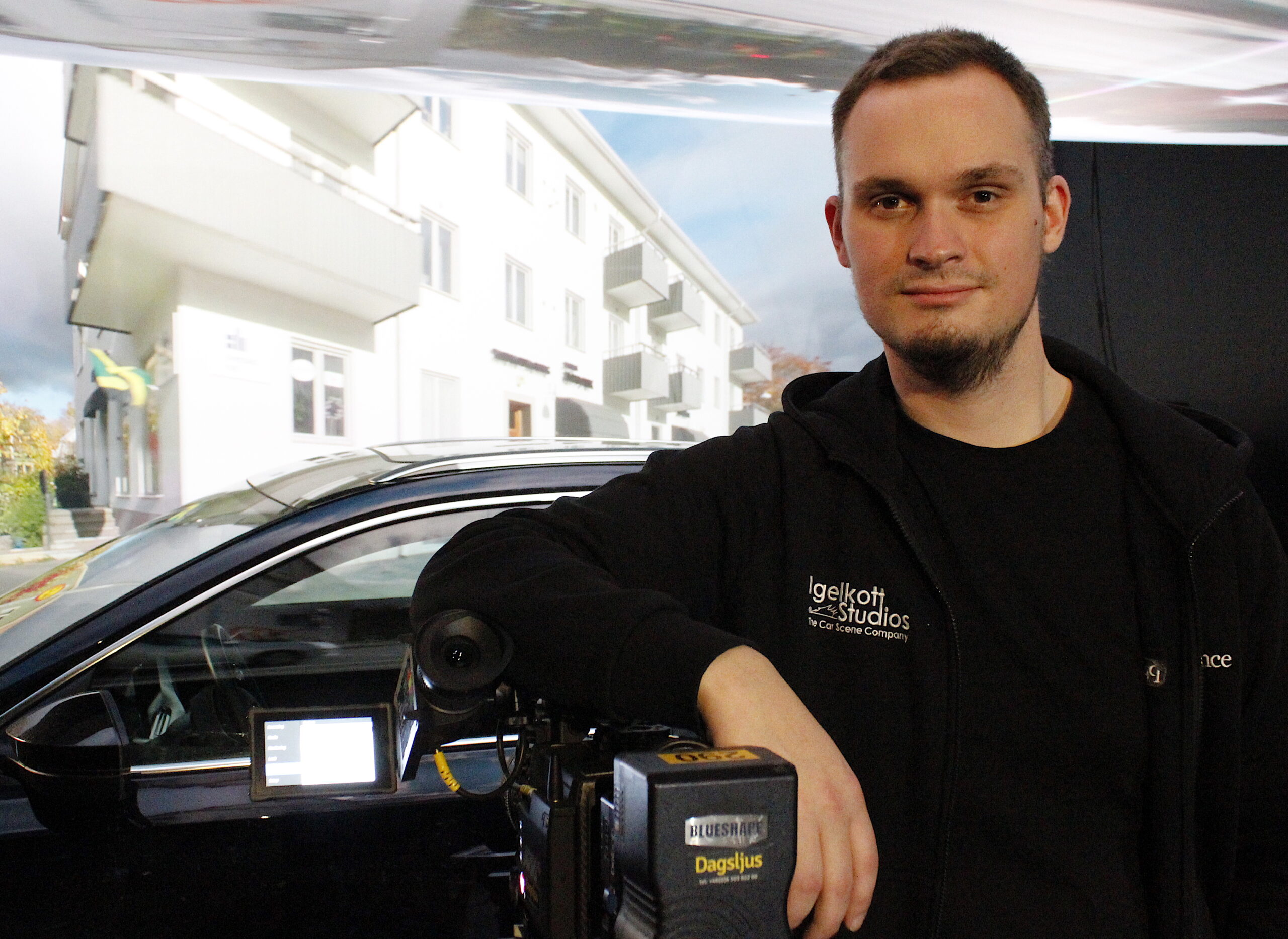
In the car set up we’re standing in front of here we are showcasing the ARRI Mini LF from Dagsljus AB, and this camera features the synch-in port, that’s an upgraded genlock developed in collaboration with Disney on their production ”The Mandalorian”, enabling the camera to sync to screens in the studio”.
”There are a lot of desirable qualities that come from a 360° source”, Eric continues, ”like uniform white balance and correct perspective. And since our 360° source material is equirectangular -like a World map- we have to apply a lot of GPU ”horsepowers” to create flat plates from that source material, and this is not a trivial task. It takes two weeks -from shooting the plates to actual car work in the studio- so it’s necessary for the client to plan the production schedule with this in mind.
We render five viewports from the processed 360° source in real time. That means the DoP can decide to shoot the car from another angle and we just change the direction of the world we’ve built up here in the studio and that’s just a 20 minute change including the actors getting in and out of the car. So it’s 20 minutes from ”camera rolling” to ”camera rolling”. And if you want to change vehicles that’s a 30 minute deal”, Eric says pointing towards the other end of the studio: ”In our studio we have a large garage door which makes changing vehicles a breeze”.
”I’m aiming for cinematic, not photo realistic, and together with the DoP we can create the story of driving a car, without the limitations of really high contrast or not being able to light the car properly. The Gaffer can give me directions if he wants any changes in the lighting, like for example a more intense light from the sky. Our light sources are the same kind of RGB light sources like the big LED walls in a virtual production studio. So it’s possible for us to, let’s say, simulate the sun coming and going when you drive past buildings; that we can simulate with a precision down to one frame of film.
Time is also an obvious limitation when you’re on location, the sun comes and goes, you’re not going to have those perfect lighting conditions for as long as you like. But if you shoot with us here in the studio it’s evening until you’re done or it’s night until you’re done. In fact, doing car scenes with us will give you an enormous sense of presence which of course is a big plus for the actors because if they’re on a process trailer all they will see is the car towing them in front…. Also our resets are so quick that the actor can stay in character through it and not have to go in and out of character”.
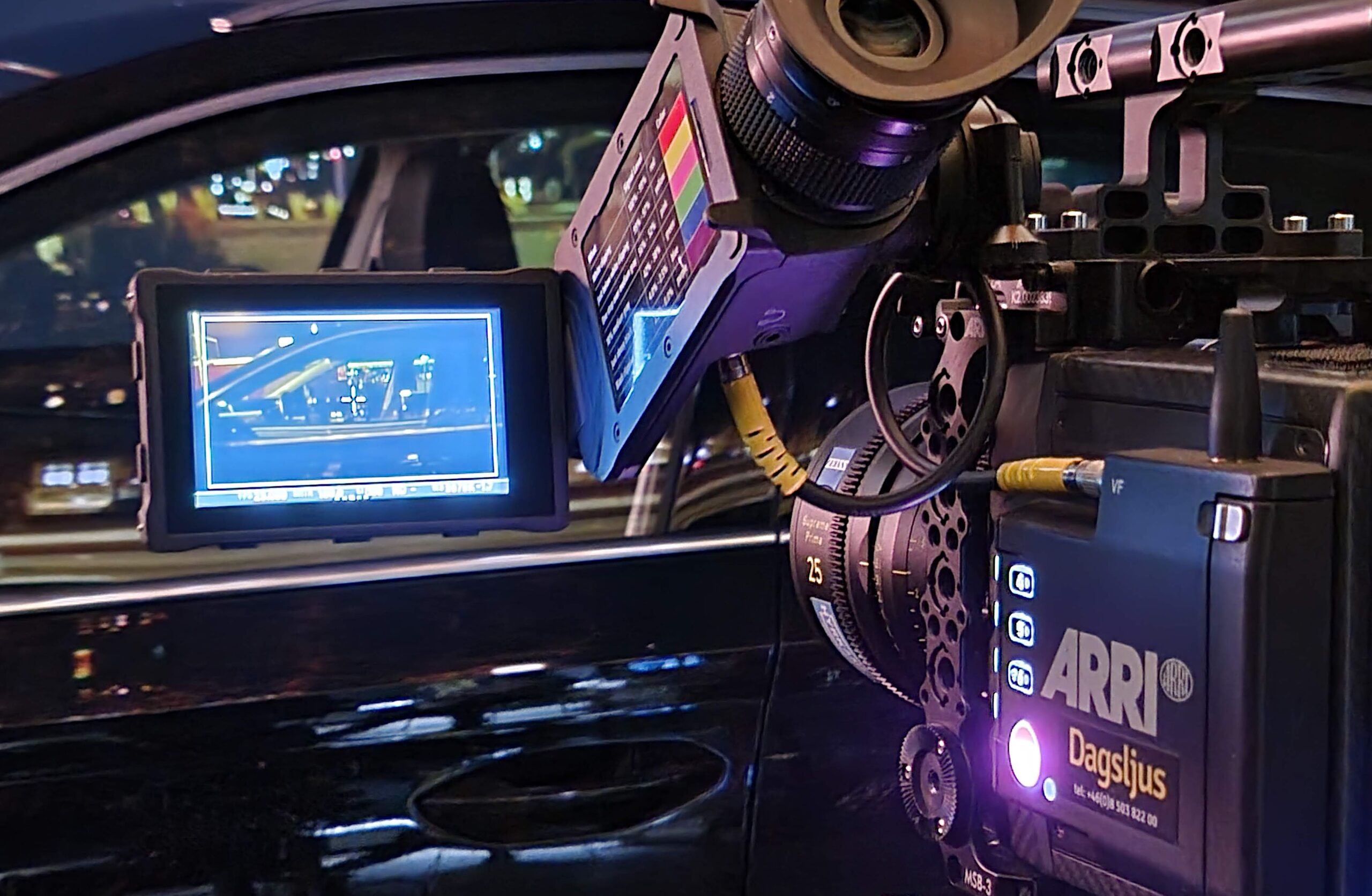
Now, this may seem far-fetched, but Eric’s biggest challenge is often the initial script meetings with the Director and the DoP. ”It’s true” he confides, ”their instinctive reaction is often ’I hate car scenes, I don’t want to do it!’ They think they’re going to be dealing with working on location on a process trailer, so the scenes are cut from the script then and there. Unless it is a DoP I’ve worked with before, I have to show them how great shooting car scenes in a studio can be these days. There’s an educational element involved here… They hear car scenes and process photography and in their mind they see what that stuff used to look like in the 1980s”.
Eric has an interesting family background. His father was a potter and used a hedgehog (Igelkott in Swedish) as the company logo, so Eric also chose to use the same animal for his company. Eric in fact sometimes sports a hairdo along the lines of a hedgehog, but ”that hairdo comes and goes” he says with a laugh.
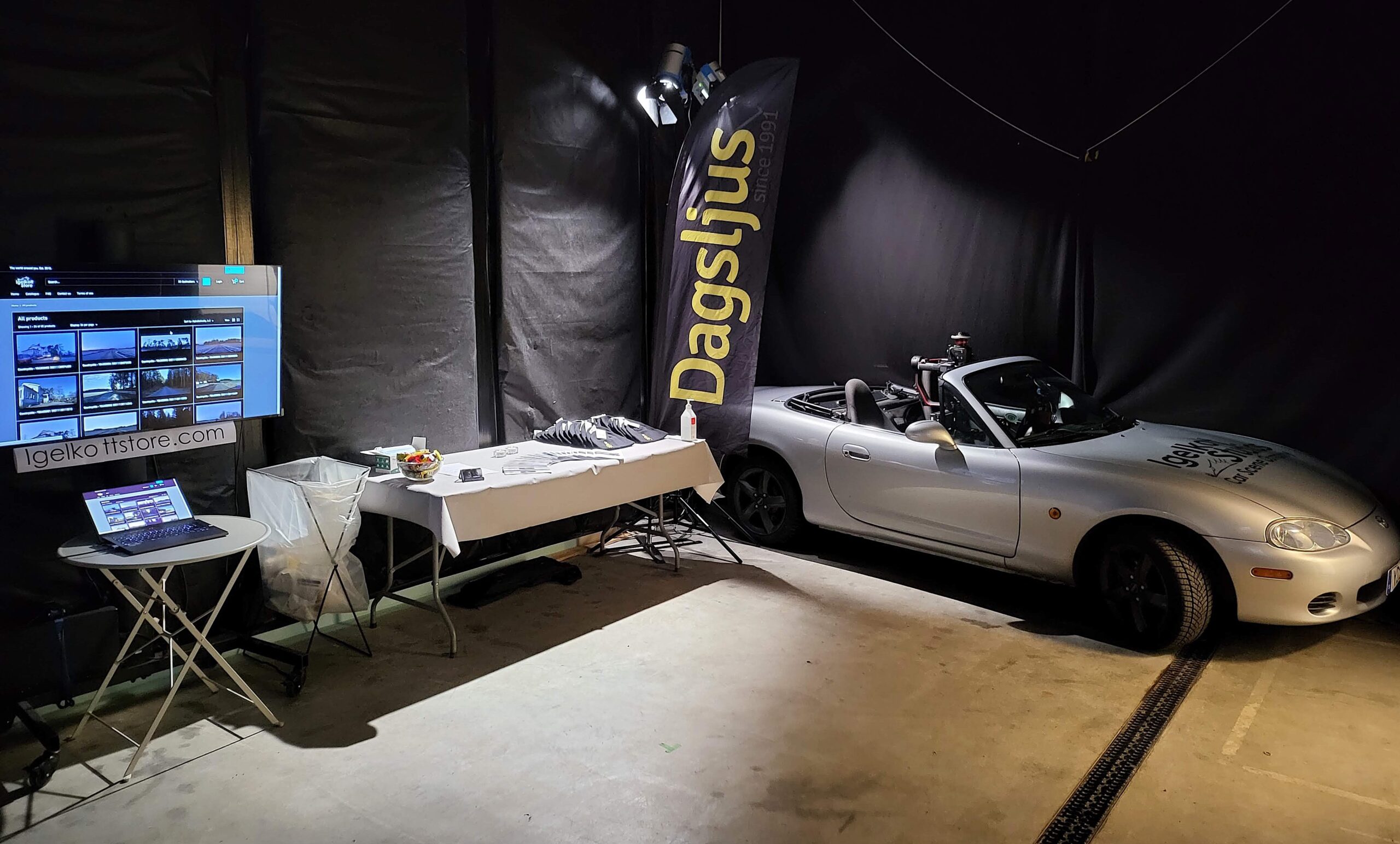
”Eric Hasso is a big fan of Miata convertible Sports cars since they allow the 360° camera lens to be rigged only 140 centimetres above the ground, which would be the eye level of a person sitting in an ordinary car”.
And Eric’s grandfather was also in the movie business. His name was Harry Hasso and he was a very prolific cinematographer in the 1930s and 40s. Born in 1904, he was a personal friend of August Arnold and Robert Richter (the founders of ARRI) and worked all over Europe. He eventually settled in Sweden, marrying some of the most beautiful Swedish actresses of the era, Signe Hasso, Viveca Lindfors and Britta Hasso. Harry Hasso loved moving camera shots and actually invented a camera crane which was revolutionary in its day.
The engineering talent has clearly been passed on to Eric, who has always been intrigued by technical challenges. When he was 13 he picked up his first camera, started a production company and never looked back, so he’s been shooting constantly for two decades now.
”We’re not limited to only doing car work in our own studio”, Eric clarifies. ”We also have extensive experience creating virtual worlds for clients at a location chosen by the production. We’ve done work in other studios here in Stockholm, in Gothenburg and abroad”.
Eric also mentions one production which was based in Lithuania but the story was supposed to take place in Malmö, Sweden. So by having Eric shoot the car plates in Malmö the production was able to convincingly make Lithuania look like Malmö in the final movie.
”Our most ambitious project so far”, he continues, ”was a Manhattan, New York City, street corner set. It was a big set extension and, in addition to an actual partially built set in the middle of the whole thing, we created a complete Manhattan street corner with 16 x 6 metre walls. Each wall had a 6K 40 000 Lumen projection and on that we front-projected 12 K plates of Manhattan. We were able to conceal our projectors in the space between the set and the screen, and this is also a big bonus using short throw projectors. compared to traditional rear projection where you need an additional 10 metres of studio space behind the projection screen.
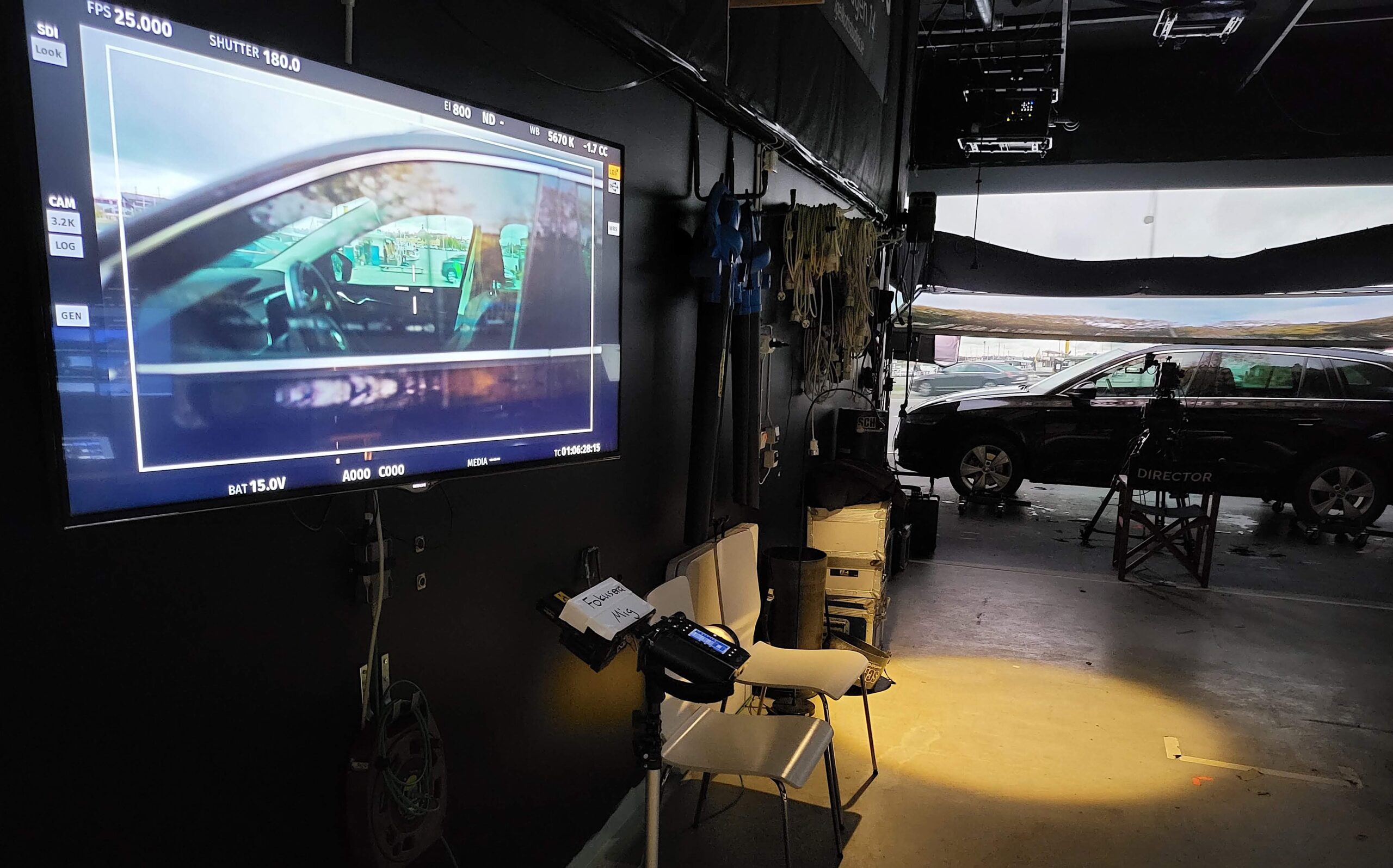
Using front projection we can retain more light (than with rear projection), retain the contrast and also get better black levels because we use a special groundbreaking paint which reduces the gain.
Insufficient black levels is the last component of failure in any projection set up of this kind. If you don’t have the black levels before you even turn on your 10Ks, or whatever your lighting is, you will not be able to create anything believable. If the shadow areas in your projection are above a certain level you can’t save them in post”.
”I would say 50% of my work consists of creating the plates and the other 50% is offering the studio for actually shooting the car scenes. Going the virtual production route means putting up a lot of money upfront, because it involves a lot of expensive equipment and R&D. But to my mind the difference between expensive and inexpensive is that expensive is when you’re not getting what you’re paying for. I think a lot of productions have gone through the experience of renting screens from one vendor, projectors from another, software from a third and then they stand there trying to shoot the car scenes and face a lot of headaches. With my experience in shooting and processing plates, and my customized studio car rig, I can offer a streamlined product where these headaches have been ironed out.
When you choose virtual production here at Igelkott Studios, you are getting minimum twice the amount of material for your editing room as compared to if you were to shoot it in the traditional fashion, and when you’re doing car scenes you’re often getting three times the material”.
Lars Pettersson FSF


















